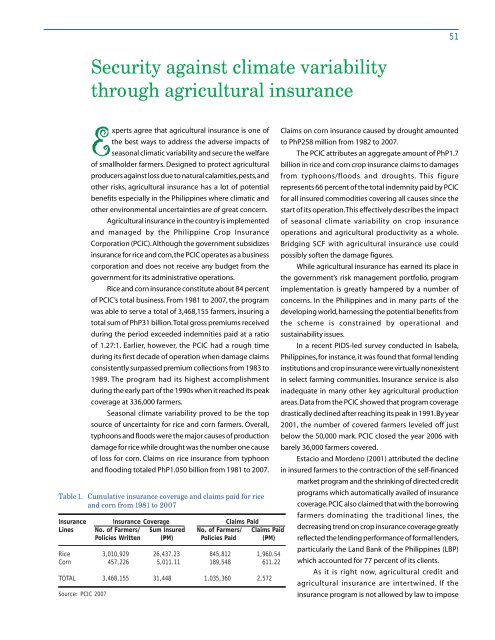Read More - Philippine Institute for Development Studies
Read More - Philippine Institute for Development Studies
Read More - Philippine Institute for Development Studies
Create successful ePaper yourself
Turn your PDF publications into a flip-book with our unique Google optimized e-Paper software.
51<br />
Security against climate variability<br />
through agricultural insurance<br />
Experts agree that agricultural insurance is one of<br />
the best ways to address the adverse impacts of<br />
seasonal climatic variability and secure the welfare<br />
of smallholder farmers. Designed to protect agricultural<br />
producers against loss due to natural calamities, pests, and<br />
other risks, agricultural insurance has a lot of potential<br />
benefits especially in the <strong>Philippine</strong>s where climatic and<br />
other environmental uncertainties are of great concern.<br />
Agricultural insurance in the country is implemented<br />
and managed by the <strong>Philippine</strong> Crop Insurance<br />
Corporation (PCIC). Although the government subsidizes<br />
insurance <strong>for</strong> rice and corn, the PCIC operates as a business<br />
corporation and does not receive any budget from the<br />
government <strong>for</strong> its administrative operations.<br />
Rice and corn insurance constitute about 84 percent<br />
of PCIC’s total business. From 1981 to 2007, the program<br />
was able to serve a total of 3,468,155 farmers, insuring a<br />
total sum of PhP31 billion. Total gross premiums received<br />
during the period exceeded indemnities paid at a ratio<br />
of 1.27:1. Earlier, however, the PCIC had a rough time<br />
during its first decade of operation when damage claims<br />
consistently surpassed premium collections from 1983 to<br />
1989. The program had its highest accomplishment<br />
during the early part of the 1990s when it reached its peak<br />
coverage at 336,000 farmers.<br />
Seasonal climate variability proved to be the top<br />
source of uncertainty <strong>for</strong> rice and corn farmers. Overall,<br />
typhoons and floods were the major causes of production<br />
damage <strong>for</strong> rice while drought was the number one cause<br />
of loss <strong>for</strong> corn. Claims on rice insurance from typhoon<br />
and flooding totaled PhP1.050 billion from 1981 to 2007.<br />
Table 1. Cumulative insurance coverage and claims paid <strong>for</strong> rice<br />
and corn from 1981 to 2007<br />
Insurance Insurance Coverage Claims Paid<br />
Lines No. of Farmers/ Sum Insured No. of Farmers/ Claims Paid<br />
Policies Written (PM) Policies Paid (PM)<br />
Rice 3,010,929 26,437.23 845,812 1,960.54<br />
Corn 457,226 5,011.11 189,548 611.22<br />
TOTAL 3,468,155 31,448 1,035,360 2,572<br />
Source: PCIC 2007<br />
Claims on corn insurance caused by drought amounted<br />
to PhP258 million from 1982 to 2007.<br />
The PCIC attributes an aggregate amount of PhP1.7<br />
billion in rice and corn crop insurance claims to damages<br />
from typhoons/floods and droughts. This figure<br />
represents 66 percent of the total indemnity paid by PCIC<br />
<strong>for</strong> all insured commodities covering all causes since the<br />
start of its operation. This effectively describes the impact<br />
of seasonal climate variability on crop insurance<br />
operations and agricultural productivity as a whole.<br />
Bridging SCF with agricultural insurance use could<br />
possibly soften the damage figures.<br />
While agricultural insurance has earned its place in<br />
the government’s risk management portfolio, program<br />
implementation is greatly hampered by a number of<br />
concerns. In the <strong>Philippine</strong>s and in many parts of the<br />
developing world, harnessing the potential benefits from<br />
the scheme is constrained by operational and<br />
sustainability issues.<br />
In a recent PIDS-led survey conducted in Isabela,<br />
<strong>Philippine</strong>s, <strong>for</strong> instance, it was found that <strong>for</strong>mal lending<br />
institutions and crop insurance were virtually nonexistent<br />
in select farming communities. Insurance service is also<br />
inadequate in many other key agricultural production<br />
areas. Data from the PCIC showed that program coverage<br />
drastically declined after reaching its peak in 1991. By year<br />
2001, the number of covered farmers leveled off just<br />
below the 50,000 mark. PCIC closed the year 2006 with<br />
barely 36,000 farmers covered.<br />
Estacio and Mordeno (2001) attributed the decline<br />
in insured farmers to the contraction of the self-financed<br />
market program and the shrinking of directed credit<br />
programs which automatically availed of insurance<br />
coverage. PCIC also claimed that with the borrowing<br />
farmers dominating the traditional lines, the<br />
decreasing trend on crop insurance coverage greatly<br />
reflected the lending per<strong>for</strong>mance of <strong>for</strong>mal lenders,<br />
particularly the Land Bank of the <strong>Philippine</strong>s (LBP)<br />
which accounted <strong>for</strong> 77 percent of its clients.<br />
As it is right now, agricultural credit and<br />
agricultural insurance are intertwined. If the<br />
insurance program is not allowed by law to impose










